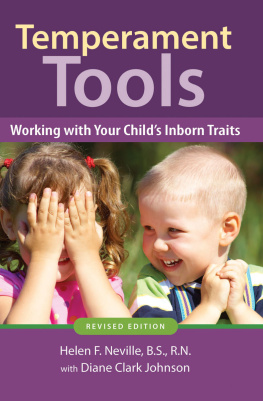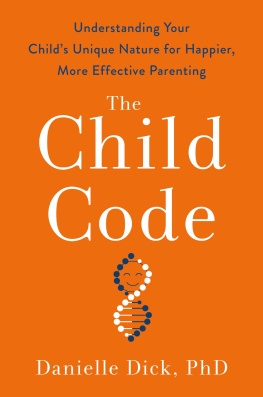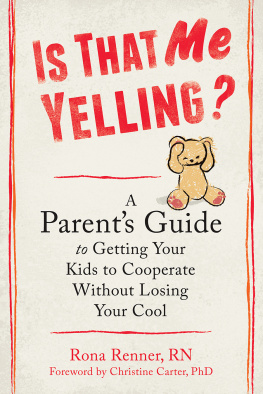First edition copyright 1998 by Helen F. Neville and Diane Clark Johnson
Revised edition copyright 2015 by Helen F. Neville
All rights reserved. No part of this book may be reproduced in any form without permission from Parenting Press, Inc.
Printed in the United States of America
ISBN 978-1-936903-25-2 paperback
Designed by Magrit Baurecht
Library of Congress Cataloguing-in-Publication Data available from the publisher
Parenting Press, Inc.
P.O. Box 75267
Seattle, Washington 98175
www.ParentingPress.com
Book distribution through Independent Publishers Group at www.ipgbook.com and 800-888-4741
Contents
Index
We dedicate this book
to our children, who continue to teach us about parenting,
to Jim Cameron, Ph.D., for his generous guidance,
and to our supportive spouses, John and Rob.
Foreword
With a bit of imagination, children can be compared to roads. Some are easy: flat, wide, straight lanes with comfortable, gradual turns and ample shoulders. Others have steep hills, sharp curves, unexpected pot holes, sudden entrances and exits, and no shoulders.
When your child is born, how do you know whether you are going to have a relaxed drive along an easy road or a hair-raising ride down a steep hill?
We once believed that all children were basically the same at birth. One map served as a guide to all children. Now we know that different children develop along different routes, depending on their temperament or behavioral style. Thus parents need more accurate maps to follow their children and plan how to ease the way through some of the difficult spots.
First, you need a clear picture of your childs temperament. Second, with that picture in mind, you need an accurate map to tell you what roadblocks may lie ahead for your child. Third, you need a set of guide-posts to help navigate those potential roadblocks. Finally, you need to know something about your own temperament and preferred parenting style, so you can pick among the guideposts to find an approach that fits you.
From years of temperament counseling with parents, both individually and in groups, Helen F. Neville and Diane Clark Johnson have developed the tools you may need. This book will help you select the individual tools that will work best for you as you pick up that map and travel along the parenting highway with your child.
~ James Cameron, Ph.D.
The Preventive Ounce
Oakland, California
1
Gifts from Birth, Inborn Traits
Most parents now know that children are different from birth. Not so long ago, researchers believed all children were born the same, but turned out differently because of how they were raised. We now know that outcome depends on both nature and nurtureparenting, education, and community. Children differ from birth, and they remain different. The goal of this book is to help you understand and bring out the best of your childs inborn temperament.
Pioneering researchers, Stella Chess, M.D., and Alexander Thomas, M.D., identified inborn traits that affect how babies take in and respond to the world. Temperament has since been studied around the world. Children everywhere are born with the same traits, even though cultures may appreciate and support different ones.
Temperament is responsible for many different behaviors. Some babies are very sensitive to clothing textures, flavors, and temperature. Some toddlers are very persistent. Children may be high or low in energy; they may have intense or mellow emotions.
Understanding temperament makes your job easier. Imagine that your new baby is like a mysterious island. A map would help! Temperament is the map that makes exploring easier and more enjoyable. When you know what to expect, you can travel with more confidence.
James Cameron, Ph.D., continued the work of researchers Chess and Thomas. He studied hundreds of temperament evaluations and found that children with similar traits often have similar behavior issues. He then explored temperament-based management tools. His work is the basis of this book.
Understanding temperament can prevent many behavior problems because parents can work with rather than against inborn traits. When parenting style and environment fit with temperament, children can thrive and grow.
How can you tell if behavior is due to temperament or something else? Ask yourself, When did this behavior begin? If it goes way back, its likely related to temperament. If it just started a few days (weeks or months) ago, its more likely due to illness, a step in development, or a reaction to personal, family, or social stress.
Understanding temperament helps avoid unnecessary blame and guilt. Though there are no bad traits, some take more work. With practice, parents can learn to appreciate and work with their childs traits. They learn not to blame children for their temperament.
It takes more skill to manage an airplane than a bicycle, and more skill and effort to manage a spirited child than a mellow one. Parents need not feel guilty when they have a harder time. Those who criticize often have easy children, and mistakenly believe their ease is due to their parenting ability.
Are traits good or bad? No. Just as bicycles, cars, and airplanes each have their own pros and cons, so it is with temperament. Sometimes its better to be very curious, sometimes very cautious. Sometimes its helpful to be very flexible and at others very determined. The goal is to discover where and how ones traits are valuable.
How does temperament relate to personality? Personality is like a layer cake. The bottom layer, temperament, is there at the beginning. Other layers get added: growth and development, relationships with family, friends, health, school, community, and all the adventures of life. Temperament affects how each child takes in and reacts to each new layer. Over time, because of inborn temperament, children are attracted to different experiences in life. This book is about the powerful bottom layer, temperament.
Does temperament change over time? Some inborn traits continue. Active babies usually become active adults. Emotional intensity generally remains high or low, as it was in the beginning. Over time, children can learn to manage their traits more effectively: the intense child learns to use words rather than hit and bite. Experience is also important. Many toddlers who are cautious or shy around new people and places are much less so by elementary school. This is simply because much more of the world is already familiar. Caution may reappear when future life changes come along.
2
What Makes My Child Tick?
Parents generally know their children better than anyone else. Fill in the temperament chart below by thinking carefully about your baby or young child. One baby always cried and arched her back in her infant seat. Her twin sat wide-eyed and still in his seat, causing the pediatrician to remark, Some babies soak up the world with their eyes. If you have more than one child, you may have seen such differences soon after birth. However, many babies need the first few months to settle in, so their true temperament is more reliably visible at 4 months.
Temperament Chart
For each of the traits, read the descriptions and consider whether your childs temperament falls at one extreme or another or is somewhere in the middle. Many children are middle of the road in most traits, but may be extreme in one or two. More rarely (and more challengingly), some are extreme in several, or most, traits. Notice that there are extremes at each end of each temperament line. Sometimes it helps to ask your partner, the childs grandparents, a child care provider or teacher, or someone else who knows the child well.
Next page






